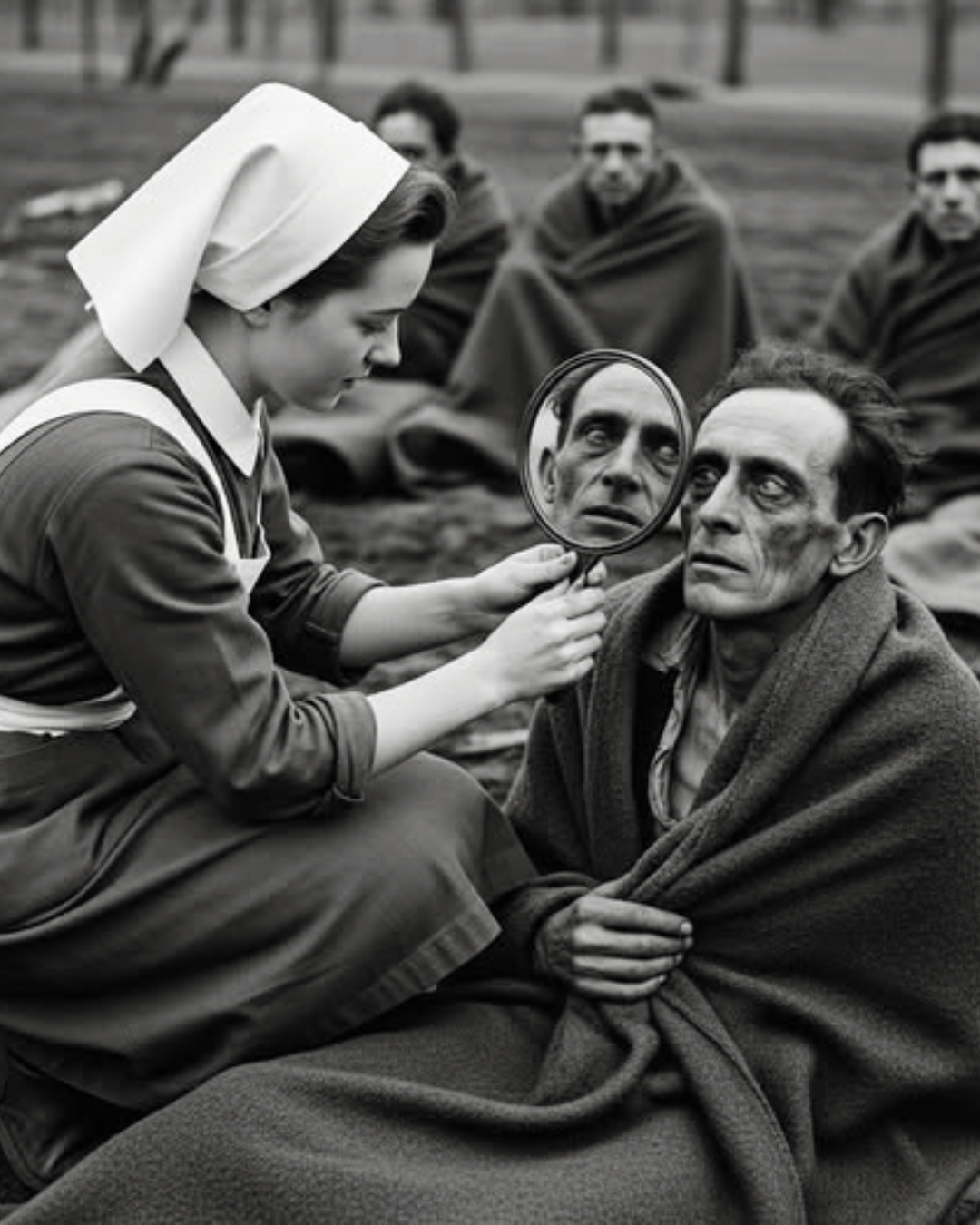The first mirror — Bergen-Belsen, 1945
No one can say precisely when this gesture was born—simple, yet burdened with an unimaginable weight. She was a British nurse, one of those who, in the first days after the liberation of Bergen-Belsen, tried to restore meaning to a place where meaning had long since died. She held a small, round mirror in her hands. Inconspicuous, fragile, so different from the brutal reality it faced. When she raised it to the face of the first survivor, silence fell. A silence that spoke louder than the screams of thousands of dead. For in that shard of glass lay a truth no one expected to see. But this was only a prelude, a prelude to something greater, the echoes of which still resonate in the dark recesses of history.
The man whose eyes rested on his own reflection couldn’t tear his gaze away. The gaunt cheeks, the sunken eye sockets, the skin drawn over the bones—the image of a living shadow. The whisper that escaped his lips was more prayer than statement: “I look like death—but I’m still breathing.” Whether it was laughter or a spasm of despair, no one could answer. One thing was certain: in that moment, he touched something he couldn’t yet name. The mirror became a portal, leading to another story. But did we ever know its ending?
The rest of the prisoners waited in line. Each, wrapped in a military blanket, looked like a ghost wandering between worlds. And as the mirror passed from hand to hand, each saw something different in it. For some, it was an encounter with their own death, a death they had successfully cheated. For others, it was a moment of awakening, when they could finally recognize themselves as people, not numbers carved into their skin. But somewhere between these glances lurked another truth, more painful and harder to accept. The question was: would anyone ever dare to speak it?
The British nurse, though she didn’t write her name into the chronicles, became a silent witness to the transformation. This wasn’t a simple reflection—it was a confrontation with a past no human would want to see. As she held the mirror to each face, her hands trembled. Perhaps she knew she wasn’t simply giving them an image of their bodies. She was giving them a fragment of their souls, still smoldering somewhere, despite years of hunger, disease, and degradation. But was she even aware that something was being created at that moment that would haunt the memories of generations?
Every survivor carried a secret. The camps taught them silence, and this silence weighed heavier than the harshest words. When they looked in the mirror, some cried, others laughed nervously, and still others averted their gaze, refusing to accept their own reflection. These reactions held a story larger than the war chronicles could bear. Each face spoke volumes, yet together they formed an image no one was prepared to see. And although we think we know what happened at Bergen-Belsen, the question remains: what did these people truly see in the glass?
Memories of these moments circulate to this day in the stories of survivors and the few witnesses. Many later said that it was at that moment that they truly felt alive for the first time. Paradoxically, not at the moment of liberation, not at the moment when the barbed wire no longer imprisoned their bodies—but precisely when they looked in the mirror and saw a man they barely recognized. This was their return to life, though painful, for it raised the question: is the one I see still me, or already someone else? And perhaps therein lies the greatest mystery—that not everyone who survived was able to truly return.
The history of small gestures is often lost in the shadow of great battles and political decisions. And yet this mirror—fragile, banal, almost laughably ordinary—became one of history’s most extraordinary witnesses. No one knows its fate. It vanished as if it had never existed. Perhaps it lies forgotten in some museum warehouse, or perhaps it was smashed when no longer needed. But there are those who believe it still exists somewhere, preserving the reflections of those who gazed into it for the first time in years. Is it possible that the fragment of glass still holds traces of those gazes?
And so the story of the first mirror from Bergen-Belsen is not just a memory of war. It is a riddle that still haunts. Each reflection was like a key to a secret no one dared fully reveal. Perhaps that is why this story keeps resurfacing – in dreams, in testimonies, in stories passed down in whispers. Because somewhere, on the border between light and shadow, the question remains: what did those eyes truly see when they looked into the mirror for the first time? And do we, looking at our reflections today, truly see the whole truth?
Note: Some content was generated using AI tools (ChatGPT) and edited by the author for creativity and suitability for historical illustration purposes.


Leave a Reply